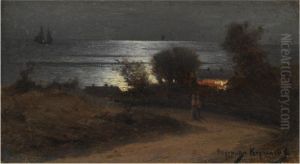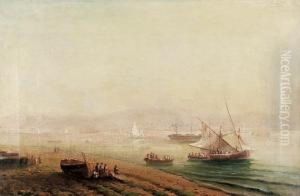Ivan Panteleimonovich Federov-Kerchensky Paintings
Ivan Panteleimonovich Federov-Kerchensky was a Russian and Soviet painter, graphic artist, and stage designer, known for his varied artistic contributions in the late 19th and early 20th centuries. He was born in 1887 in the city of Kerch, which is situated in the eastern part of the Crimean Peninsula. This region has a rich history that provided a backdrop of cultural influences that would later be reflected in Federov-Kerchensky's art.
Federov-Kerchensky's early education and training are not well-documented, but it is known that he was active during a period of intense social change and artistic experimentation in Russia. He participated in the vibrant cultural life of the pre-revolutionary era, which was characterized by a mix of traditional and avant-garde artistic movements. Federov-Kerchensky worked in various mediums including painting, graphic arts, and theater set design, which allowed him to engage with a wide spectrum of the Russian art community.
With the outbreak of World War I and the subsequent Russian Revolution, Federov-Kerchensky's career would have been impacted by the dramatic shifts in politics, society, and culture. Many artists of the time were caught up in the turmoil of the period, and the establishment of the Soviet Union would eventually lead to a transformation in the role and function of art in society. Federov-Kerchensky, like many of his contemporaries, may have grappled with the challenges of creating art under a new regime that promoted a very specific and politically driven aesthetic.
Ivan Panteleimonovich Federov-Kerchensky died in 1942, during World War II. His death came at a time when the Soviet Union was deeply embroiled in the conflict, which also had a significant impact on the country's artistic output. Unfortunately, due to the limited available information on Federov-Kerchensky, his legacy is not as well-known as that of some of his peers, and much of his work and contributions to Russian and Soviet art may have been overlooked or lost in the subsequent decades. Nonetheless, he remains a figure of interest for those studying the diverse and complex tapestry of Russian art history.

